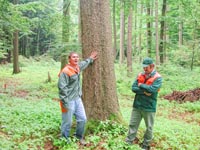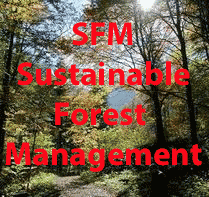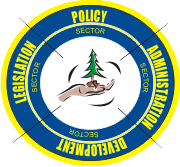Sustainable Forest Management (SFM)
Sustainable Forest Management (SFM) is seen to be a key factor to REDD+►
and it is a good deal more than Reduced Impact Logging (RIL) ►
Want to know some background info regarding Tree-Economics?►
|
|
Definition of SFM by European Forest Convention: "Sustainable forest management” means the stewardship and use of forests and forest lands in a way, and at a rate, that maintains their biodiversity, productivity, regeneration capacity, vitality and their potential to fulfill, now and in the future, relevant ecological, economic and social functions, at local, national and global levels, and that does not cause damage to other ecosystems; Definition of SFM by UN + FAO: A/RES/62/98► Definition of SFM by UNFF: Sustainable forest management as a dynamic and evolving concept aims to maintain and enhance the economic, social and environmental value of all types of forests, for the benefit of present and future generations► Definition of SFM by CIFOR: Managing (permanent) forest to achieve one or more clearly specified objectives of management with regard to the production of a continuous flow of desired forest products and services (e.g. carbon) without undue reduction of its inherent values and future productivity and without undue undesirable effects on the physical and social environment► |
Bali Action Plan refers to SFM
In the Bali Action Plan, SFM refers to the application of forest management practices for the primary purpose of sustaining constant levels of carbon stocks over time, but the we note states that implicit in the term SFM is that other values of the forest should not be disregarded.
|
"SFM, according to internationally agreed language, is a dynamic and evolving concept that aims to maintain and enhance the economic, social and environmental value of all types of forests, for the benefit of future generations" |
What are the values of SFM?
- Wood and Non-timber forest products: SFM provides wood and non-timber forest products as essential products that can also, to a large extent, substitute for products from non-renewable resources, as well as provide energy and a multitude of other goods, services and functions, which will be necessary for the welfare of society and the environment for the foreseeable future
- Ecosystem Services: SFM provides optimal combinations of goods and services to nations and to local populations economically and environmentally sound. Multiple-use forestry to achieve an appropriate balance between the various needs of society is an essential part of SFM.
- Permanence: SFM is based on stable and long-term land-use policies and regulations, which, inter alia, are aimed at conserving functional forest ecosystems
Holistic approach
Never the less Sustainable Forest Management can not be seen in isolation from rural development and land use planning. Forests are a substantial and integrated part of the rural areas. Therefore SFM must closely fit into national, regional and local treatment of the rural environment. People living at rural land are closely interacting with forests. Either by chopping down forest for agriculture needs, by harvesting forest products and using ecosystem services of forests for their livelihood or by relaying on the protective functions of their forests. Sustainable Forest management is able to manage the provision of all those functions in parallel as long as it will be treated as an integrative part of rural development and of land use planning.
|
Forest management practices forming part of SFM
- Inventory: As SFM is based on periodically updated plans or programmes at local, regional and national levels, as well as for ownership units, forest surveys, assessments of ecological impact and on scientific knowledge and practical experience must
- Planning: to the development and implementation of management policies and regulations based on long-term planning
- Policies: as adapted to local laws within the framework of national traditions and constitutional processes, should recognise the long-term nature of forestry by having an appropriate level of continuity in legal, institutional and operational matters and should strongly encourage practices in state and private forests which facilitate multiple functions and sustainable management
- Safeguards: SFM has due regard to the protection of areas of ecological fragility, to safeguarding the quality and quantity of water, and to maintaining and developing other protective functions of forests such as the protection of aquatic and agricultural ecosystems and protection against floods, erosion and avalanches
Contribution of Sustainable Forest Management to poverty reduction
Sustainable Forest Management is quite a controversial subject when beeing discussed in the general public. One aspect of many is on how SFM can contribute to a reduction of poverty. Below you can find five viewpoints on how SFM can reduce poverty. It is an example of the remarkable wide range of rationale...
| Advancing Poverty Reduction & Rural Livelihoods through Sustainable Commercial Forestry►► | The Contribution of Forests and Trees to Poverty Alleviation►► | Sustainable Forest Management, Biodiversity and Livelihoods►► | Trick or Tread? REDD, Development and Sustainable Forest Management►► |
The four dimensions of Sustainable Forest Management (SFM):
| LOCAL | SOCIO-ECONOMIC | ECOLOGICAL | GLOBAL |
| Rural livelihood | Timber products | Biodiversity | Carbon storage |
| Ecosystem services | Non-Timber Forest Products | Wildlife | Climate regulation |
We offer support in any kind of sustainable forest management!










